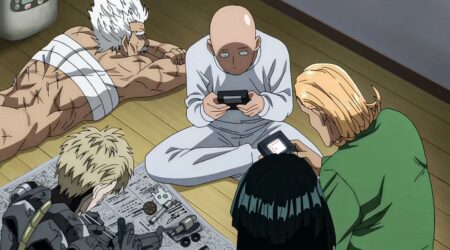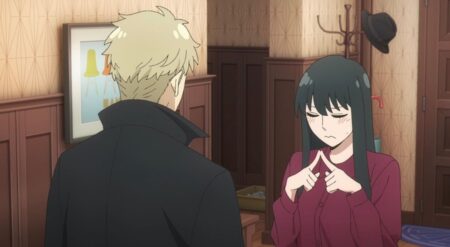
Originally released in 1998 from Sunrise, the Cowboy Bebop anime series is a space western from Shinichiro Watanabe and it was not only an instant hit in Japan but was also one of the first anime to explode in popularity here in America. With the upcoming live-action adaptation less than a month away, Netflix has started streaming this anime classic. With the series coming to a whole new audience, we figured it was time to give this classic a rewatch and review for all the people who may be finding it for the first time.
In the future, humanity has colonized the solar system. Utilizing hyperspace gates, people can move from planet to planet swiftly, allowing commerce between the various colonies to be a practical thing. However, the solar system is a big place. As a result, it’s become harder for law enforcement to track down and apprehend criminals. So, to supplement the shortcomings of police agencies, humanity has turned to bounty hunters. Huge sums of money are offered for the most notorious criminals. It takes a particular brand of person to go after these crooks. Like the kind of people you find aboard the spaceship Bebop.
When Cowboy Bebop opens, we are introduced to Spike Spiegal and his partner, Jet Black. These two are traveling the stars hunting bounties. But times are tough, and funds are running low. Not because they can’t catch bounties, but more because Spike can get a bit over-enthusiastic in his pursuit of perps. The opening scene of the show’s pilot episode “Asteroid Blues” is one of the best introductory exchanges in television history. So much about Jet and Spike, both as individuals, as well as partners, is brought to the viewer through such an unassuming interaction that you can’t fully appreciate it the first time you see it. But once you roll credits on the entire series, I highly recommend you go back and watch those first few minutes again. They are perfect.
While this series opens with just the duo aboard the Bebop, the cast soon expands to include the adorable Welsh Corgi/data dog Ein, hustler and perpetually short on cash hard-case Faye Valentine, and possibly the best hacker in the system, Edward. As each new character boards the Bebop, they bring a new element to the personality of the crew. Each character quickly melds into the dynamic of the interactions, misadventures, and drama that comprise Cowboy Bebop‘s 26 episodes so much that you quickly find yourself forgetting they weren’t all aboard from the start.
While the main cast of Cowboy Bebop brings a ton of personality to the series, who they are at this moment only makes up half the appeal of these characters. One of the key narrative elements of the series is the pasts that Spike, Jet, and Faye have following them. Whether it’s Jet’s time with the police, Spike’s years with the biggest crime syndicate on Mars, or Faye’s history of betrayal and manipulation, the show’s always exploring how who these characters were impacts and informs who they are now. Whether in the past or the present, Cowboy Bebop does something with its characters few shows are willing to. It is perhaps the single most critical reason the series’ storytelling hits so perfectly—the cast lacks the customary plot armor of most tv show protagonists.
Without going back and counting, I’d be willing to bet the crew of the Bebop only manage to catch about half of their targets. This isn’t because they are bumbling goofs, but rather circumstance is allowed to foul up the works on them. Targets die, escape, or get picked up by rival hunters, depriving the team of their reward and often their next meal. Without the sense that our protagonists cannot fail, everything about the show becomes tenser. Whether it’s a dogfight in outer space or a shoot-out in a bar, the circumstances always feel more desperate with how much the show strives to keep its cast’s fallibility intact.
The other critical aspect that keeps Cowboy Bebop grounded in realism, even as it soars between planets, is the consistency of its cast’s moral compasses. These are people living on the fringes of humanity that sometimes do bad things and look the other way when bad things happen even more often. Throughout the series, the cast stays true to their personalities, behaving in ways that feel accurate to the presented character. While there are some lines they will not cross, and they certainly have their altruistic moments, these characters are the show’s protagonists; they are not heroes, though.
There is only one area where I can see someone possibly complaining about Cowboy Bebop’s narrative. There is a noticeable lack of character development amongst the cast. With only one character that has what could be defined as a character arc, the rest of the cast are extremely static. As a result, their choices at the end of the show feel exactly like the ones they would make at the beginning. While I give this a pass because it fits in with how the show takes a realistic approach to its cast’s personality, I can see where some could find it to be the chip in an otherwise flawless narrative armor.
Now we come to a point in our look at Cowboy Bebop that I usually wouldn’t talk about, but here I must: the choice of audio track used when watching this series. While I firmly believe everyone should experience media in the manner that is their preference, I have to recommend listening to the English dub of this series. While there are frequent complaints levied against English dubs of anime, this is possibly the best dub job ever done. The casting of Steve Blum as Spike Spiegel, Beau Billingslea as Jet Black, Wendee Lee as Faye Valentine, and Melissa Fahn as Edward are some of the best casting choices in television history. The tone, timing, and delivery of every line are pure art.
As the name of the series and our protagonists’ vessel hint at, music is a critical component of the Cowboy Bebop anime and comes from composer Yoko Kanno. Throughout every episode, music is used far more prominently than in most tv shows. From the opening credits playing out to wild beats of “Tank!” to the melodic closing sounds of “The Real Folk Blues,” every episode brings with it a unique sound. And even though most of the show’s music falls in the range of jazz and blues, some episodes go as far afield as heavy metal—a sound for every story.
The final area that this series excels in is its visual presentation. For an over 20-year-old anime, the show has lost little of its luster. The tense space fight and fluid combat animation look nearly as smooth now as they did then. It’s like a Jurassic Park of anime. Sure, the new stuff looks prettier, but you’ll never complain about having to look at this either.
So, when all is said and done, the original Cowboy Bebop anime delivers a true work of television art. Its characters, narrative, sound, and animation are nearly flawless in all regards. This isn’t just the best anime I’ve ever seen; it’s my favorite television series of all time. I cannot recommend this show enough.
The original Cowboy Bebop anime is streaming on Netflix and Funimation.
Cowboy Bebop
-
Rating - 10/1010/10
TL;DR
Cowboy Bebop delivers a true work of television art. Its characters, narrative, sound, and animation are nearly flawless in all regards. This isn’t just the best anime I’ve ever seen; it’s my favorite television series of all time. I cannot recommend this show enough.







